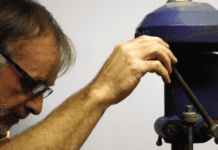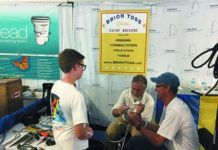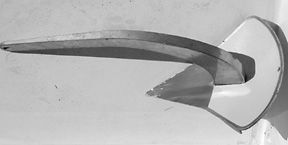
Since 1995, Practical Sailor editors have, late in each year, pored over the gear product reports published in the preceding 12 months and pulled together an end-of-the-year article summarizing 10 exemplary products.
It’s not a simple chore to pick the year’s best. From an initial compilation, it’s easy enough to peel off the bottom, dealing away the bottom of the deck, so to speak. However, as the list gets whittled down, pure unanimity of opinion is hard to come by.
As always, the products in the final running must embody clear superiority, innovation, and practical value. It’s often true that the best is the most expensive, but in Practical Sailors view, something that costs twice as much must step out very smartly.
For the year 2001, here, in no considered order or rank, is the gear that survived the gauntlet.
Simrad TP30 Tillerpilot
There are but two makers left of tillerpilots, the low-cost alternative to belowdeck wheel pilots-Simrad (which absorbed the familiar Navico brand name) and Raymarine. (At the time of the review, Raymarine was Raytheon. As far as we can tell, their tillerpilots still go by the name of Autohelm-but who can keep up?)
In the January 1 issue, PS reviewed two models from each company. Working up in price, they were Simrad’s TP10, a stand-alone with its own fluxgate compass (no interface), a drivescrew device that sells at discount for about $400, and three recirculating ball types-the Autohelm ST2000 Plus, a $630 model intended for boats up to 36′; the Simrad TP30, a $670 model for up to 42′, and the Autohelm ST4000 Plus, a $900, no-compromise steerer intended for sailors who work their boats hard on long passages.
PS put these tillerpilots through their paces on a rugged bench-mounted tiller with a gantry rig and a hanging block that permitted swinging weights from 20 to 44 pounds to oppose the tiller while measuring hard-over times and electrical consumption.
The set-up produced a fine set of numbers, which, blended with some other considerations, led to the conclusion that if you want a simple helping hand at the helm, without the complications of connections to other instruments, Simrad’s TP10 would be “a good sturdy choice.”
Stepping up a good bit in power (always a good idea if it can be done economically) and adding interface capability produced a quandary: It was difficult to choose between Raytheon’s ST2000 and the Simrad TP30. Both are recirculating ball types, and both are fine units.
With a slight edge in power consumption and a slightly longer travel, the Simrad TP30 got the nod as Practical Sailors top choice.
Spade Anchor
Making its second appearance in the Gear-of-the-Year derby is an aluminum anchor that has been a stand-out in Practical Sailors series of anchor tests-the Spade.
Because anchoring is a complicated undertaking made even trickier by widely varying conditions, Practical Sailor’s testing, started in 1997, was broken into segments. In the first summer’s test, having to do with setting in sand, the top three anchors were the Bulwagga, the Spade, and the Bruce.The second set of tests, the following summer, was concerned with holding power in sand. The top three were the Spade, Bulwagga and CQR.
The mud-setting test was won by the Delta anchor, with six others tied for second.
For holding power in mud, the top anchors were the Barnacle, the CQR, and the Bulwagga.
As reported in the January 15, 2001 issue, the latest anchor test was to study which anchors best withstood having the direction of the load changed radically (between 140 and 150). Particular attention was given to whether an anchor pulled free and had to reset or simply swiveled to accommodate a load from a different direction.
In this latest test with 18 anchors, two anchors failed to reset, 14 lost ground as they broke out and reset or swiveled to meet the new direction of pull. Only the Supermax and the Spade showed no linear movement; they rotated smoothly in a horizontal plane, without ever losing their grip on the bottom.
It should be noted that the light aluminum Spade seems to set and bury at least as well as heavier steel anchors of the same size and rated for similar-sized boats.
The multiple-test approach and the Spade’s consistent showing make it the first product to make two appearances on Gear-of-the-Year lists.
Lewmar Rope Clutch
Practical Sailor has a lot of experience testing rope clutches. PSs tests (covered in reports issued in 1987, 1991, 1994, and 1996) are an on-going project to test holding power, line abrasion, and ease of bleeding line under tension.
In our April 15, 2001 issue, the history of the rope clutch was reviewed, beginning with their introduction in the 1980s.
Rope clutches were the successors to rope-eating sheet stoppers, and they have progressed rapidly in design and operation to become among the most useful gear aboard any boat.
A high point in rope clutch history was reached in 1991 when Lewmar introduced its “falling rings” Superlock models. By avoiding the use of teeth to assure holding power, the Lewmar Superlocks minimized wear on the line.
The April 15 report was occasioned by the introduction of several new models, which were “run” against the field of competitors including Antal, Francespar, Garhauer, Lewmar, and Spinlock.
Because it’s always gratifying to comment on progress, Practical Sailor was pleased to conclude, “All of these modern clutches now hold so well that slippage is not much of a factor. More important, especially to the shorthanded cruiser, is how easy a clutch is on the line and how easy it is to operate.”
It was somewhat unusual that the latest round of tests indicated that Lewmar’s Superlock was still the champ. It holds very well and is the most convenient to bleed-all with “no discernible line abrasion.”
King of the Hill, surely, but one of these days…stay tuned.
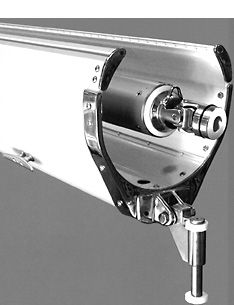
Leisure Furl
Stowing mainsails by winding them up, rather than fighting them down to the boom and punching them into submission, is an innovation that has developed rapidly-although efficient mainsail furling has proved a lot harder to accomplish than jib furling.
Innovators have tried stacking systems, lazy jacks, and in-mast systems. Beginning in the 1980s with Ted Hood’s “noble experiment” (called the Stoboom), attention focused on using the boom to stow the main. In-boom stowage avoids many of the many disadvantages of in-mast stowage.
We think it’s a still-developing field.
For our latest look at how it’s going, we evaluated at five in-boom systems: Leisure Furl, from New Zealand; the John Mast Hi-Lo Reefer; the smooth new Schaefer package; ProFurl, and Furlboom.
One overall conclusion: They all work. What we liked least about all of them is the welter of controls, prohibitions and warnings that go with them. They take some accommodation, which would go along with familiarity, of course. What’s best is the industry’s record of constant improvement.
Leisure Furl seems like the most rugged, proven performer, but the new Schaefer design, based on the better qualities of systems that have come before, also looks promising.
Pains Wessex MK 7
There’s probably nothing that, over the entire range of the testing done by Practical Sailor, is as disappointing as safety equipment that doesn’t perform as expected.
The daytime distress signals we tested this past summer were a case in point. Even discounting advertising claims, we were a bit shocked: The smoke devices we tested, from several manufacturers, were barely visible in the testing conditions, which consisted of a clear day with a fairly strong breeze.
Once deployed, all the smoke ended up staying close to the water’s surface, blowing to leeward in wispy, thin threads. It was weak when seen from close by, and barely visible from a one-mile vantage point.
As it turned out, the most effective daytime distress device (in the wind) was what had previously been shown as the most effective nighttime device-a high-intensity flare.
And it was the Pains Wessex MK 7 Handflare that worked the best.
If you want to have aboard a fair arsenal of daytime distress signaling equipment, the choice from Practical Sailor would be three of the above-mentioned flares, a distress flag, a three-pack of Pains Wessex Pinpoint Handheld Orange Smoke Signals, and a signaling mirror. For night use, aerial flares are still hard to beat.
Tommy Tape
Quite often, it’s the little stuff that matters-something you need to keep discomfort or maybe even disaster at bay. It’s that odd machine screw, a couple of batteries, a piece of sandpaper… On a boat, anything can be important.
That’s why Practical Sailor tests some odd products, even those that cost relatively little. It’s always good to know which is best.
It took 12 months to do it and only a little space to publish the results of an exposure test of seven varieties of what is called elastomeric self-bonding or self-amalgamating tape.
It’s handy stuff, this tape that stretches all over the place, sticks to itself, and morphs almost into a solid.
The seven candidates were wrapped tightly on a cylinder (with a wooden dowel interposed), a section of mast, and a piece of tubing.
Hung by a string to twist in the sun and wind, the samples were checked at monthly intervals. The first failure came in only three months. Others failed at 7 months, 10 months, and 11 months.
Still intact after 12 months of exposure, Tommy Tape, a common brand available at hardware stores and through the manufacturer’s website, was the winner.
Tommy Tape does not carry the premium price frequently slapped on any common product when packaged for the marine trade. It was not only the best; it was the Best Buy.
Ritchie Globemaster Compass
Nothing is more pleasurable than handling fine marine gear-like winches, rope of all kinds, blocks and, perhaps best of all, compasses!
So it was a joy to collect 18 steering compasses for Practical Sailor’s evaluation. Instruments came from famous firms like Plath, Danforth, Ritchie, and Suunto. Included were binnacle, bulkhead, bracket, and flush-mount versions.
Several interesting models were shown only in photos: One was our executive editor’s vintage, new-in-the-box, grid-steering Sestrel. Now everyone wants one, but none seems to be available.
In essense, a compass is a simple device: Rub a needle, put a bit of finger oil on it, place it carefully in a shallow dish of water, and you have a compass no better nor worse in principle than one that costs a thousand dollars.
But the accoutrements are vital. So these compasses were put through their paces for damping (speed of settling), limits of swing, readability (which is closely related to card size, both real and apparent), effectiveness of the cover, and appearance.
Ranking such high-quality equipment is difficult. And the selection of a steering compass is always dependent on the space available and the owner’s preferences.
So what resulted from this test and evaluation, published in the August 1 issue, were three groups of ratings.
Top-ranked in the top group was the Ritchie Globemaster. Subsequent places in the top group went to the Ritchie Navigator, the Ritchie Voyager, the new Danford C401W (for either sail or power) and the glass-domed Plath Venus.
Premier Red Shines
Practical Sailor’s principal line of work concerns boat reviews and marine gear. However, we don’t always stick slavishly to form. The primrose path of simple curiosity can lead to products that can hardly be labeled as marine equipment, but that are always found on or around boats.
Thus, when someone said “Let’s do sandpaper,” it made good sense to everyone: Almost all boat owners use it, sometimes in great quantity. It’s almost always in the middle of a chore that’s physically difficult and a pain in the neck. Thus, it’s important to know which paper can make the job least onerous, and for the best price.
It turned out to be a fascinating subject involving considerable planning and, ultimately, 12 kinds of sandpaper from makers like Carborundum, Indasa, Mirka, Norton, Sears, Sungold, and 3M.
The testing was done on five surfaces-enamel, West System Epoxy, bottom paint, varnish, and two-part paint. All resist the sandpaper in different ways.
The quest was to determine which paper cut the fastest (making the job easier) and which loaded up the least, thus needing changing less often.
It was a long project involving a lot of grunt work, but when the dust settled, one conclusion jumped up, yelling and screaming, from the workbench: The best paper is far better than the cheap paper; the premium papers more than make up the price differential by working better and lasting far longer.
The best of all were Carborundum’s Premier Red, Norton’s new Blue (A975) and 3M’s Imperial Purple. Premier Red had an edge, but not much. Look for any of these three. If your local source doesn’t carry them, look up a source on the Internet and buy direct.
West Marine Explorer Dry Bag
Some Practical Sailor reports get done simply because we, like you, are exposed to advertising that makes claims that seem either hard to believe or perhaps have, in similar circumstances, turned out to be hokum.
Now, most sailors sooner or later need a duffel bag. They might get invited to sail on a friend’s boat; or head off to the races or a weekend cruise, or even need to travel to a charter in waters thought to be more exotic than those at home.
Many of these bags are said by their makers to be waterproof or splashproof, or are even described as “Dry as the Desert.”
OK, says we-let’s fill the pool.
We gathered up 26 bags and pouches from seven manufacturers. It got close to out-of-hand, but much time was given to a spray test (with paper towels in the bags); a sit-in-the-water test (an overnight soak), and, to check fabric strength, straps and sewing, a weight test (load them with bricks and jerk them around like that gorilla in the baggage area in the old Samson TV spot).
Kudos were won by Watershed’s Colorado Duffel, for its large bags, and by Cascade’s SealLine, for its small bags.
But the grand prize went to West Marine’s Explorer Dry Bag, which will keep things dry under most conditions and costs but $19.
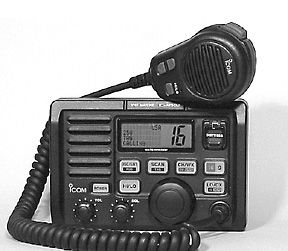
Icom IC-M502
The fixed-mount VHF radio is probably the commonest electronic instrument found on anything afloat. It has occupied that priority position for many years.
Despite cell phones and other highly-touted forms of communication (some of which work marginally better than empty tomato cans connected with string) the fixed-mount VHF probably will continue to be what you might call “primary,” especially because, in an emergency, people within line-of-sight of your antenna will hear you.
As marine radio has galloped along rapidly in the last decade, Practical Sailor has stayed on top of developments, with many reviews of fixed-mounts, handhelds, high-priced, and economy models.
For the latest test, reported in the August 1 issue, PS returned to Square One with a thorough shakedown of 11 fixed-mounts from six manufacturers-Icom, Uniden, Alinco, Raymarine, Shakespeare, and Standard.
A check was made of such items as transmitting power, audio quality, receive sensitivity, frequency stability, and a half dozen other performance and handling features.
The testing indicated that in the marine VHF field, Icom continues to lead the pack. Standard’s radios were impressive. Shakespeare and Alinco radios were adequate but didn’t stand out.
The top performer was the Icom IC-M502, which sells for about $300. For almost $100 less, the Icom IC-M402 wasn’t far behind.
Contacts- Cascade, 4000 1st Ave. S., Seattle, WA 98134; 800/531-9531. Carborundum & Norton, 800/268-2262 or 800/377-0331. Danforth, Rule Industries (ITT), Cape Ann Industrial Park, Gloucester, MA 01930; 978/281-0573; www.rule-industries.com/. Icom, 2380 116th Ave. NE, Bellevue, WA 98004; 425/454-8155; www.icomamerica.com/. Leisure Furl, Forespar Products Corp., 22322 Gilberto, Rancho Santa Margarita, CA 92688; 949/858-8820; www.forespar.com/. Lewmar, 351 New Whitfield St., Guilford, CT 06437; 203/458-6200; www.lewmar.com/. 3M, 3M Marine Center, Bldg. 250-1-02, St. Paul, MN 55144; 651/737-417; www1.3m.com/. Pains Wessex, Box 25, Glen Iris, Victoria, Australia 3146; (61) 03-9885-0444. Ritchie, 234 Oak, Pembroke, MA 02359; 781/826-5131; www.ritchienavigation.com/. Schaefer, 158 Duchaine Blvd., New Bedford, MA 02745; 508/995-9511; www.schaefermarine.com/. Simrad, 19210 33rd Ave. West Lynnwood,WA 98036; 425/778-8821. Spade, BP 103-40, Rue Ibn Bchir Safouane, 2036 La Soukra, Tunesia; www.info@spade-anchor.com. Tommy Tape, Box 555, Palm City, FL 34991; 561/223-1991. Watershed, 2000 Riverside Dr., Asheville, NC 28804; 828/252-7111; www.drybags.com/. West Marine, Box 50050, Watsonville, CA 95077; 800/262-8464; www.westmarine.com/.






























